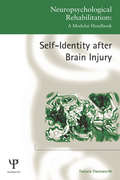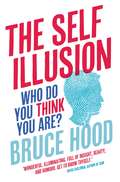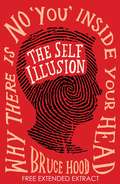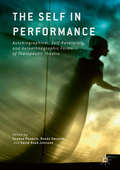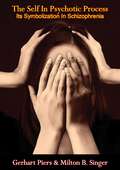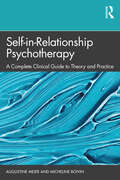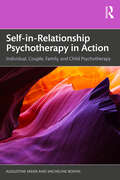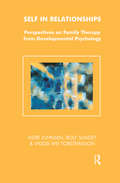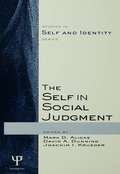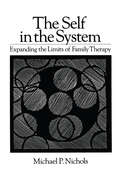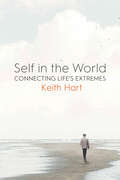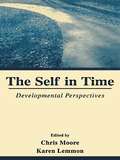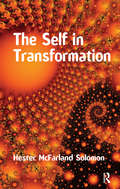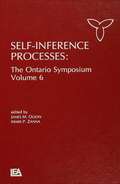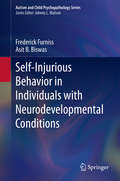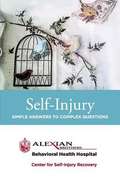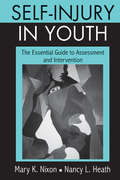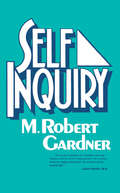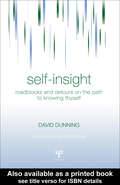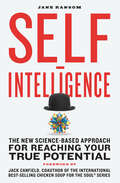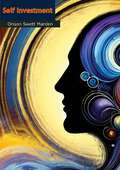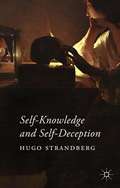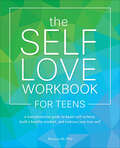- Table View
- List View
Self Hypnosis for a Better Life
by William W. HewittFrom the book: WE HAVE the ability to solve most, if not all, of our problems in life if we know how. Self-hypnosis is one tool that can help us solve our problems and create better lives for ourselves. This book gives actual word-for-word self-hypnosis scripts for twenty three major problem-solving situations. Most of them will most likely apply to you at some point in your life. ... This book also includes very understandable explanations of what hypnosis is and how it works.
Self-Identity after Brain Injury (Neuropsychological Rehabilitation: A Modular Handbook)
by Tamara OwnsworthAn injury to the brain can affect virtually any aspect of functioning and, at the deepest level, can alter sense of self or the essential qualities that define who we are. In recent years, there has been a growing body of research investigating changes to self in the context of brain injury. Developments in the cognitive and social neurosciences, psychotherapy and neurorehabilitation have together provided a rich perspective on self and identity reformation after brain injury. This book draws upon these theoretical perspectives and research findings to provide a comprehensive account of the impact of brain injury on self-identity. The second half of this book provides an in-depth review of clinical strategies for assessing changes in self-identity after brain injury, and of rehabilitation approaches for supporting individuals to maintain or re-establish a positive post-injury identity. The book emphasizes a shift in clinical orientation, from a traditional focus on alleviating impairments, to a focus on working collaboratively with people to support them to re-engage in valued activities and find meaning in their lives after brain injury. Self-Identity after Brain Injury is the first book dedicated to self-identity issues after brain injury which integrates theory and research, and also assessment and intervention strategies. It will be a key resource to support clinicians and researchers working in brain injury rehabilitation, and will be of great interest to researchers and students in clinical psychology, neuropsychology, and allied health disciplines.
The Self Illusion: Why There is No 'You' Inside Your Head
by Bruce HoodMost of us believe that we possess a self - an internal individual who resides inside our bodies, making decisions, authoring actions and possessing free will. The feeling that a single, unified, enduring self inhabits the body - the 'me' inside me - is compelling and inescapable. This is how we interact as a social animal and judge each other's actions and deeds. But that sovereignty of the self is increasingly under threat from science as our understanding of the brain advances. Rather than a single entity, the self is really a constellation of mechanisms and experiences that create the illusion of the internal you.We only emerge as a product of those around us as part of the different storylines we inhabit from the cot to the grave. It is an ever changing character, created by the brain to provide a coherent interface between the multitude of internal processes and the external world demands that require different selves.
The Self Illusion (Extract): Why There is No 'You' Inside Your Head
by Bruce HoodThis is an extended extract from The Self Illusion: Why There is No 'You' Inside Your Head.Most of us believe that we possess a self - an internal individual who resides inside our bodies, making decisions, authoring actions and possessing free will. The feeling that a single, unified, enduring self inhabits the body - the 'me' inside me - is compelling and inescapable. This is how we interact as a social animal and judge each other's actions and deeds. But that sovereignty of the self is increasingly under threat from science as our understanding of the brain advances. Rather than a single entity, the self is really a constellation of mechanisms and experiences that create the illusion of the internal you.We only emerge as a product of those around us as part of the different storylines we inhabit from the cot to the grave. It is an every changing character, created by the brain to provide a coherent interface between the multitude of internal processes and the external world demands that require different selves.
The Self in Performance: Autobiographical, Self-Revelatory, and Autoethnographic Forms of Therapeutic Theatre
by Susana Pendzik, Renée Emunah and David Read JohnsonThis book is the first to examine the performance of autobiographical material as a theatrical form, a research subject, and a therapeutic method. Contextualizing personal performance within psychological and theatrical paradigms, the book identifies and explores core concepts, such as the function of the director/therapist throughout the creative process, the role of the audience, and the dramaturgy involved in constructing such performances. It thus provides insights into a range of Autobiographic Therapeutic Performance forms, including Self-Revelatory and Autoethnographic Performance. Addressing issues of identity, memory, authenticity, self-reflection, self-indulgence, and embodied self-representation, the book presents, with both breadth and depth, a look at this fascinating field, gathering contributions by notable professionals around the world. Methods and approaches are illustrated with case examples that range from clients in private practice in California, through students in drama therapy training in the UK, to inmates in Lebanese prisons.
The Self In Psychotic Process: Its Symbolization In Schizophrenia
by John Weir Perry C. G. JungC.G. Jung started as a psychiatric learning from schizophrenic patients. Among the Jungian school, only John Weir Perry has continued this line of Jung's work with such depth of understanding, clinical acumen, and the ability to write beautifully. Perry's therapy in the California Bay Area with acute episodes in young psychotic patients brought him national and international renown. The case of the young housewife diagnosed catatonic schizophrenic demonstrates the interpenetration of collective symbols and individual processes as they come to light in 'breakdown' (Part One), and extends knowledge of the psyche by elucidating symbols of the Self (Part Two).-Print ed.
Self-in-Relationship Psychotherapy: A Complete Clinical Guide to Theory and Practice
by Augustine Meier Micheline BoivinIn this innovative book, the authors set out their theory of Self-in-Relationship Psychotherapy (SIRP), advocating for the integration of relational, self, and physical intimacy needs in the conceptualization and treatment of psychological problems, placing human needs at the center of treatment. This marks a shift in how psychological and relational problems are understood, currently being perceived in terms of affects, cognitive processes and behaviors. Using numerous illustrations from their own clinical practice, Meier and Boivin contend that this understanding overlooks the pivotal role that needs play in all aspects of peoples’ personal lives and relationships. Children, adolescents, and adults do not live primarily from feelings and thoughts, but from basic psychological and relational, needs such as wanting to be in a meaningful relationship, having the autonomy and freedom to make decisions about their lives, experiencing being competent, being regarded as a significant and important person, and experiencing emotional, intimate, and sensual and/or sexual connections. By taking such an approach this book stands out among other books on psychotherapy theories. Authored by two seasoned psychologists who have provided therapeutic services to children, adolescents, and adults for 40 years, this book comprises the foundational theory for practicing Self-in-Relationship Psychotherapy, making it of interest to graduate students, clinicians in training, and practicing psychologists, social workers, and psychotherapists alike.
Self-in-Relationship Psychotherapy in Action: Individual, Couple, Family and Child Psychotherapy
by Micheline Boivin Augustine MeierThis book presents a comprehensive guide to applying Meier and Boivin's Self-in-Relationship Psychotherapy model to clinical work with individuals, couples, families and children.The central theme of the book is that the paradigm of affects, cognitive processes and behaviors that informs current psychotherapy approaches needs to be broadened to include core self, relational and physical intimacy needs as motivating factors in psychotherapy. Drawing on multiple influences including relational psychoanalysis, the authors illustrate how to work with core needs when providing therapy to children and adults. They establish that core needs are universal, and their realizations are essential for healthy living and argue that clients achieve the healthiest outcomes by finding a way to balance the self alongside their relations with others. The concept of core self, relational and physical intimacy needs is what binds all the chapters in this book and makes it unique among psychotherapy approaches.With a clear transtheoretical approach and rich clinical vignettes, this book is core reading for any psychotherapists, psychoanalyst, or practicing psychologists.
Self in Relationships: Perspectives on Family Therapy from Developmental Psychology (The Systemic Thinking and Practice Series)
by Astri Johnsen Rolf Sundet Vigdis Wie Torsteinsson Daniel Stern David Campbell Ros DraperInspired by Daniel Stern's work on self-development, the authors suggest that by combining systemic therapy with a psychoanalytical aspect, family therapy can reach new depths. They argue that this will enrich our understanding of the relationships beween parents and children, and between siblings. There have been changes within psychoanalysis and family therapy which we believe can enrich both these theoretical fields. The idea is not to integrate but rather to bring about a mutual curiosity in these two areas, which may result in dialogues with each other and create reservoirs for ideas and practices which have been found to be useful.
The Self in Social Judgment (Studies in Self and Identity)
by Mark D. Alicke David A. Dunning Joachim I. KruegerThe volume begins with a historical overview of the self in social judgment and outlines the major issues. Subsequent chapters, all written by leading experts in their respective areas, identify and elaborate four major themes regarding the self in social judgment:· the role of the self as an information source for evaluating others, or what has been called 'social projection'· the assumption of personal superiority as reflected in the pervasive tendency for people to view their characteristics more favorably than those of others· the role of the self as a comparison standard from or toward which other people's behaviors and attributes are assimilated or contrasted· the relative weight people place on the individual and collective selves in defining their attributes and comparing them to those of other people
Self In The System: Expanding The Limits Of Family Therapy
by Michael P. NicholsFirst published in 1988. Routledge is an imprint of Taylor & Francis, an informa company.
Self in the World: Connecting Life's Extremes
by Keith HartEminent anthropologist Keith Hart draws on the humanities, popular culture and his own experiences to help readers explore their own place in history. We each embark on two life journeys – one out into the world, the other inward to the self. With these journeys in mind, anthropologist, amateur economist and globetrotter Keith Hart reflects on a life of learning, sharing and remembering to offer readers the means of connecting life’s extremes – individual and society, local and global, personal and impersonal dimensions of existence and explores what it is that makes us fully human. “This is a work of great originality. Keith Hart has had an unorthodox academic career and it has liberated him in many ways from academic pieties. His background in African ethnography gives him a fascinating angle on all sorts of things, not least the possibility of a more African-influenced global future. The book is full of surprises and mind-shifting observations. I actually couldn't put it down.”—Sherry B. Ortner, UCLA From the introduction: People have many sides, but I will focus here on two. Each of us is a biological organism with a historical personality that together make us a unique individual. But we cannot live outside society which shapes us in unfathomable ways. Human beings must learn to be self-reliant (not self-interested) in small and large ways: no-one will brush your teeth for you or save you from being run over while crossing the street. We each must also learn to belong to others, merging personal identity in a plethora of social relations and categories. Modern ideology insists that being individual and mutual is problematic. The culture of capitalist societies anticipates a conflict between them. Yet they are inseparable aspects of human nature.
The Self in Time: Developmental Perspectives
by Chris Moore Karen LemmonHuman reasoning is marked by an ability to remember one's personal past and to imagine one's future. Together these capacities rely on the notion of a temporally extended self or the self in time. Recent evidence suggests that it is during the preschool period that children first construct this form of self. By about four years of age, children can remember events from their pasts and reconstruct a personal narrative integrating these events. They know that past events in which they participated affect present circumstances. They can also imagine the future and make decisions designed to bring about desirable future events even in the face of competing immediate gratification. This book brings together the leading researchers on these issues and for the first time in literature, illustrates how a unified approach based on the idea of a temporally extended self can integrate these topics.
The Self in Transformation
by Hester McFarland SolomonThis book brings together into one volume a number of articles that the author has written over the past 20 years, and includes a new extended essay written especially for this volume. The chapters, organized into sections, explore theoretical and clinical matters within a Jungian analytical framework, making carefully considered links to a number of psychoanalytical themes and concepts. The book also includes a section on ethics in the consulting room. In her new essay, the author discusses pivotal themes in depth psychology: psychic transformation, synchronicity, and the emergence of complex adaptive systems in relation to the evolution of Jungs theory of the psychoid. She draws from fields of study such as anthropology, neuropsychology, the arts and religion to develop her themes. This is a reasoned integration and demonstration of the developing thought and clinical practice of an established Jungian analyst.
The Self in Understanding and Treating Psychological Disorders
by Michael KyriosThis must-have reference is a unique exploration of how the individual notion of 'self' and related constructs, such as early schemas and attachment styles, impact on psychopathology, psychotherapy processes and treatment outcomes for psychological disorders across DSM-5, such as depression, bipolar and schizophrenia spectrum disorders, anxiety and trauma, eating disorders, obsessive-compulsive and related disorders, autism, personality disorders, gender identity disorder, dementia and somatic problems such as chronic fatigue syndrome. It discusses the role of the concept of self in a wide range of existing theoretical and treatment frameworks, and relates these to real-life clinical issues and treatment implications. Emphasizing the importance of integrating an awareness of self constructs into evidence-based conceptual models, it offers alternative practical intervention techniques, suggesting a new way forward in advancing our understanding of psychological disorders and their treatment.
Self-Inference Processes: The Ontario Symposium, Volume 6 (Ontario Symposia on Personality and Social Psychology Series)
by James M. Olson Mark P. ZannaAlthough self-inference processes -- the ways individuals make judgments about themselves -- have been studied in social psychology and sociology for many years, a distinct literature on this topic has not emerged due to the diversity of relevant issues. The editors of this current volume cull recent social psychological research and theory on self-inference processes and identify some of the common themes in this area of study. The specific topics covered in this volume include: ` how people infer their emotions, personality traits, and body images from relevant information * factors influencing the self-concept, identity, and self-standards * the impact of self-inferences on interpersonal relations * conditions motivating escape from the self The book is written for researchers and graduate level students in clinical, social, developmental, health, and personality psychology.
Self-Injurious Behavior in Individuals with Neurodevelopmental Conditions (Autism and Child Psychopathology Series)
by Frederick Furniss Asit B. BiswasThis book addresses self-injurious behavior (SIB) in individuals with various neurodevelopmental conditions (NDCs). It takes a cross-NDC perspective that synthesizes recent research on variability in incidence and presentation across NDCs and the natural history and neurobiology of SIB. Chapters examine implications for biobehavioral definitions of subtypes of SIB and provide a detailed guide to assessment and intervention using an integrated research-based model for individualized treatment. In addition, chapters present a practice-focused structure using case studies to illustrate clinical implications of research findings. The book concludes with a discussion of current directions in research and their potential to guide innovation in prevention and treatment of SIB.Topics featured in this handbook include:· Self-restraint among individuals who self-injure.· Self-injurious behavior in individuals with autism spectrum conditions.· Assessing and managing short-term effects of SIB.· Reducing risk of, and responding to, relapse following successful intervention with SIB.· Ethical issues associated with working with people who engage in self-injurious behaviors.Self-Injurious Behavior in Individuals with Neurodevelopmental Conditions is a must-have resource for researchers, clinicians and practitioners as well as graduate students in the fields of clinical child and school psychology, applied behavior analysis, pediatrics, social work, developmental psychology, behavioral therapy/rehabilitation, child and adolescent psychiatry, clinical psychology and psychiatry of adult intellectual disability, and special education.
Self Injury: Simple Answers to Complex Questions
by Jason J. WashburnThis book intends to provide a comprehensive, authoritative, yet simple and accessible read for understanding, assessing, and treating self-injury.
Self-Injury in Youth: The Essential Guide to Assessment and Intervention
by Mary K. Nixon Nancy L. HeathThis edited volume features evidence-based reviews and practical approaches for the professional in the hospital, clinic, community and school, with case examples throughout. Divided into five major sections, the book offers background historical and cultural information, discussion of self-injury etiology, assessment and intervention/prevention issues, and relevant resources for those working with youths who self-injure.
Self Inquiry
by M. Robert GardnerFirst published in 1989. Routledge is an imprint of Taylor & Francis, an informa company.
Self-Insight: Roadblocks and Detours on the Path to Knowing Thyself (Essays in Social Psychology)
by David DunningPeople base thousands of choices across a lifetime on the views they hold of their skill and moral character, yet a growing body of research in psychology shows that such self-views are often misguided or misinformed. Anyone who has dealt with others in the classroom, in the workplace, in the medical office, or on the therapist’s couch has probably experienced people whose opinions of themselves depart from the objectively possible. This book outlines some of the common errors that people make when they evaluate themselves. It also describes the many psychological barriers - some that people build by their own hand - that prevent individuals from achieving self-insight about their ability and character. The first section of the book focuses on mistaken views of competence, and explores why people often remain blissfully unaware of their incompetence and personality flaws. The second section focuses on faulty views of character, and explores why people tend to perceive they are more unique and special than they really are, why people tend to possess inflated opinions of their moral fiber that are not matched by their deeds, and why people fail to anticipate the impact that emotions have on their choices and actions. The book will be of great interest to students and researchers in social, personality, and cognitive psychology, but, through the accessibility of its writing style, it will also appeal to those outside of academic psychology with an interest in the psychological processes that lead to our self-insight.
Self-Intelligence: The New Science-Based Approach for Reaching Your True Potential
by Jane Ransom“Count yourself lucky to have found this book. It contains some of the most fascinating information and material you will ever read.” —Jack Canfield, New York Times–bestselling author of The Success PrinciplesSelf-Intelligence is the self-help book for people who long to transform their lives and who trust only proven scientific tools, but also prefer page-turners to dry prose.Cutting-edge brain science meets superb storytelling as readers learn proven techniques to break through inner gridlock, sustain high performance, and achieve their dreams. All of this is possible due to neuroplasticity, the revolutionary discovery that we can literally re-form our brains by strategically choosing our thoughts, actions, and experiences.First came emotional intelligence, then came social intelligence. Here, at last, Self-Intelligence provides the big picture, incorporating the latest research from diverse scientific fields. Mental coach and transformational trainer Jane Ransom lays out for you the new Self-Intelligence™ model, which she has used to help countless clients achieve the positive change they previously found impossible.You’ll be uplifted, motivated to move forward, and simply fascinated. The author, who also is a master hypnotist, devotes a riveting chapter to the art and science of hypnosis. Throughout the book, she shares intriguing behind-the-curtain glimpses of its applications.By following the easy, clear precepts of Self-Intelligence, you can finally achieve your true potential and take the scientific short-cuts to greater success. You’ll be empowered to avert old obstacles and achieve tangible goals.“Entertaining and erudite, Self-Intelligence busts self-help myths while providing scientific tools to help ordinary people achieve extraordinary results.” —John J. Ratey, MD, Harvard Medical School professor and author of A User’s Guide to the Brain
Self Investment
by Orison Swett MardenTransform your life by investing in your greatest asset—yourself—with Orison Swett Marden’s empowering book, "Self-Investment." This inspiring work offers timeless wisdom and practical advice on personal development, encouraging readers to cultivate their inner strengths and realize their fullest potential.Orison Swett Marden, a pioneering figure in the self-help movement and an influential author, emphasizes the importance of self-investment as the foundation for success and fulfillment. In "Self-Investment," Marden explores the key principles of personal growth, including the development of self-discipline, the power of a positive mindset, and the importance of continuous learning.Through engaging anecdotes and motivational insights, Marden illustrates how self-investment leads to greater confidence, resilience, and achievement. He provides practical strategies for setting and reaching goals, overcoming obstacles, and maintaining a healthy work-life balance. Marden’s guidance helps readers understand that investing in oneself is the most effective way to create a life of purpose and satisfaction."Self-Investment" covers a wide range of topics, from the cultivation of intellectual and emotional intelligence to the importance of physical health and well-being. Marden emphasizes the interconnectedness of these aspects, showing how a holistic approach to self-investment can lead to a more balanced and successful life.Marden’s writing is both inspirational and actionable, making complex concepts accessible and applicable to daily life. His teachings encourage readers to take proactive steps towards personal and professional growth, highlighting the significance of self-belief and perseverance.This book is an essential read for anyone looking to enhance their personal and professional lives. Whether you are a student, an entrepreneur, a professional, or someone seeking to improve your overall well-being, "Self-Investment" offers the tools and motivation needed to invest wisely in your future.Join Orison Swett Marden on a journey of self-discovery and empowerment, and learn how to invest in yourself to achieve lasting success and fulfillment. With "Self-Investment," you can unlock your potential and create the life you’ve always dreamed of.
The Self-Love Workbook for Teens: A Transformative Guide to Boost Self-Esteem, Build Healthy Mindsets, and Embrace Your True Self
by Shainna AliDiscover how to change your attitude, build confidence in who you are, and genuinely love yourself through the guided activities and real-world advice in this easy-to-use, friendly workbook for teens and young adults. As a teen, life can be stressful, whether from worrying about looks, performance in school, relationships with friends and family, or societal pressures. It is easy for you to lose focus and feel like you&’re not good enough. The Self-Love Workbook for Teens gives you the tools to conquer self-doubt and develop a healthy mindset. It includes fun, creative, and research-backed exercises, lessons, and tips, including: Interactive activities Reflective exercises Journaling prompts Actionable advice Self-love is a journey, but it is the first step on the path to a happier, more fulfilling life.

